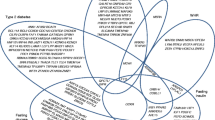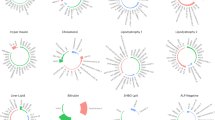Abstract
Metabolic syndrome (MetS) is a common complex trait consisting of the clustering of abdominal obesity, hypertension, dyslipidemia, and dysglycemia. MetS is found in about 25% of the population in the United States and is associated with increased risk for type 2 diabetes and cardiovascular disease. Despite research into possible genetic influences for MetS, no consistently reproducible genetic markers have been obtained, partially due to lack of agreement on the definition of the phenotype. Because phenotypic precision is essential for genomic interrogation, the evolving discipline of clinical phenomics, which uses objective and systematic acquisition of phenotypic data (ie, “deep phenotyping”), may help evaluate the genetic influences of MetS. This article reviews evidence that MetS has a genetic component and the potential applicability of clinical phenomics for the genetic evaluation of MetS using the example of hierarchical cluster analysis of phenotypic components of lipodystrophy syndromes, which serve as monogenic models of MetS.
Similar content being viewed by others
References and Recommended Reading
Reaven GM: Banting lecture 1988. Role of insulin resistance in human disease. Diabetes 1988, 37:1595–1607.
Lemieux I, Pascot A, Couillard C, et al.: Hypertriglyceridemic waist: a marker of the atherogenic metabolic triad (hyperinsulinemia; hyperapolipoprotein B; small, dense LDL) in men? Circulation 2000, 102:179–184.
Kaplan NM: The deadly quartet. Upper-body obesity, glucose intolerance, hypertriglyceridemia, and hypertension. Arch Intern Med 1989, 149:15140–1520.
Ferrannini E: The insulin resistance syndrome. Curr Opin Nephrol Hypertens 1992, 1:291–298.
Vague J: The degree of masculine differentiation of obesities: a factor determining predisposition to diabetes, atherosclerosis, gout, and uric calculous disease. Am J Clin Nutr 1956, 4:20–34.
World Health Organization: Definition, diagnosis, and classification of diabetes mellitus and its complications. Report of a WHO Consultation. Available at http://www.staff.newcastle.ac.uk/philip.home/who_dmc.htm.1999. Accessed December 2, 2007.
Executive Summary of The Third Report of The National Cholesterol Education Program (NCEP) Expert Panel on Detection, Evaluation, And Treatment of High Blood Cholesterol In Adults (Adult Treatment Panel III). JAMA 2001, 285:2486–2497.
Balkau B, Charles MA: Comment on the provisional report from the WHO consultation. European Group for the Study of Insulin Resistance (EGIR). Diabet Med 1999, 16:442–443.
Einhorn D, Reaven GM, Cobin RH, et al.: American College of Endocrinology position statement on the insulin resistance syndrome. Endocr Pract 2003, 9:237–252.
Grundy SM, Cleeman JI, Daniels SR, et al.: Diagnosis and management of the metabolic syndrome: an American Heart Association/National Heart, Lung, and Blood Institute Scientific Statement. Circulation 2005, 112:2735–2752.
Alberti KG, Zimmet P, Shaw J: The metabolic syndrome—a new worldwide definition. Lancet 2005, 366:1059–1062.
Kahn R, Buse J, Ferrannini E, Stern M: The metabolic syndrome: time for a critical appraisal. Joint statement from the American Diabetes Association and the European Association for the Study of Diabetes. Diabetologia 2005, 48:1684–1699.
Grundy SM: Does the metabolic syndrome exist? Diabetes Care 2006, 29:1689–1692; discussion 1693–1686.
Ford ES, Giles WH, Dietz WH: Prevalence of the metabolic syndrome among US adults: findings from the third National Health and Nutrition Examination Survey. JAMA 2002, 287:356–359.
Park YW, Zhu S, Palaniappan L, et al.: The metabolic syndrome: prevalence and associated risk factor findings in the US population from the Third National Health and Nutrition Examination Survey, 1988–1994. Arch Intern Med 2003, 163:427–436.
Malik S, Wong ND, Franklin SS, et al.: Impact of the metabolic syndrome on mortality from coronary heart disease, cardiovascular disease, and all causes in United States adults. Circulation 2004, 110:1245–1250.
Hunt KJ, Resendez RG, Williams K, et al.: National Cholesterol Education Program versus World Health Organization metabolic syndrome in relation to all-cause and cardiovascular mortality in the San Antonio Heart Study. Circulation 2004, 110:1251–1257.
Hanley AJ, Karter AJ, Williams K, et al.: Prediction of type 2 diabetes mellitus with alternative definitions of the metabolic syndrome: the Insulin Resistance Atherosclerosis Study. Circulation 2005, 112:3713–3721.
Joy T, Lahiry P, Pollex RL, Hegele RA: Genetics of metabolic syndrome. Curr Diab Rep 2007, In press.
Pollex RL, Hegele RA: Genetic determinants of the metabolic syndrome. Nat Clin Pract Cardiovasc Med 2006, 3:482–489.
Bodhini D, Radha V, Dhar M, et al.: The rs12255372(G/T) and rs7903146(C/T) polymorphisms of the TCF7L2 gene are associated with type 2 diabetes mellitus in Asian Indians. Metabolism 2007, 56:1174–1178.
Horikoshi M, Hara K, Ito C, et al.: A genetic variation of the transcription factor 7-like 2 gene is associated with risk of type 2 diabetes in the Japanese population. Diabetologia 2007, 50:747–751.
Chandak GR, Janipalli CS, Bhaskar S, et al.: Common variants in the TCF7L2 gene are strongly associated with type 2 diabetes mellitus in the Indian population. Diabetologia 2007, 50:63–67.
Wang J, Joy T, Mymin D, et al.: Phenotypic heterogeneity of sitosterolemia. J Lipid Res 2004, 45:2361–2367.
McCarroll SA, Altshuler DM: Copy-number variation and association studies of human disease. Nat Genet 2007, 39:S37–S42.
Schork NJ: Genetics of complex disease: approaches, problems, and solutions. Am J Respir Crit Care Med 1997, 156:S103–S109.
Edwards KL, Newman B, Mayer E, et al.: Heritability of factors of the insulin resistance syndrome in women twins. Genet Epidemiol 1997, 14:241–253.
Lin HF, Boden-Albala B, Juo SH, et al.: Heritabilities of the metabolic syndrome and its components in the Northern Manhattan Family Study. Diabetologia 2005, 48:2006–2012.
Kissebah AH, Sonnenberg GE, Myklebust J, et al.: Quantitative trait loci on chromosomes 3 and 17 influence phenotypes of the metabolic syndrome. Proc Natl Acad Sci U S A 2000, 97:14478–14483.
Arya R, Blangero J, Williams K, et al.: Factors of insulin resistance syndrome-related phenotypes are linked to genetic locations on chromosomes 6 and 7 in nondiabetic Mexican-Americans. Diabetes 2002, 51:841–847.
Langefeld CD, Wagenknecht LE, Rotter JI, et al.: Linkage of the metabolic syndrome to 1q23–q31 in Hispanic families: the Insulin Resistance Atherosclerosis Study Family Study. Diabetes 2004, 53:1170–1174.
Loos RJ, Katzmarzyk PT, Rao DC, et al.: Genome-wide linkage scan for the metabolic syndrome in the HERITAGE Family Study. J Clin Endocrinol Metab 2003, 88:5935–5943.
Hsueh WC, St Jean PL, Mitchell BD, et al.: Genome-wide and fine-mapping linkage studies of type 2 diabetes and glucose traits in the Old Order Amish: evidence for a new diabetes locus on chromosome 14q11 and confirmation of a locus on chromosome 1q21–q24. Diabetes 2003, 52:550–557.
Ng MC, So WY, Lam VK, et al.: Genome-wide scan for metabolic syndrome and related quantitative traits in Hong Kong Chinese and confirmation of a susceptibility locus on chromosome 1q21–q25. Diabetes 2004, 53:2676–2683.
Kobberling J, Williams B, Kattermann R, Creutzfeldt W: Lipodystrophy of the extremities. A dominantly inherited syndrome associated with lipotrophic diabetes. Humangenetik 1975, 29:111–120.
Dunnigan MG, Cochrane MA, Kelly A, Scott JW: Familial lipoatrophic diabetes with dominant transmission. A new syndrome. Q J Med 1974, 43:33–48.
Garg A, Peshock RM, Fleckenstein JL: Adipose tissue distribution pattern in patients with familial partial lipodystrophy (Dunnigan variety). J Clin Endocrinol Metab 1999, 84:170–174.
Garg A, Vinaitheerthan M, Weatherall PT, Bowcock AM: Phenotypic heterogeneity in patients with familial partial lipodystrophy (Dunnigan variety) related to the site of missense mutations in lamin a/c gene. J Clin Endocrinol Metab 2001, 86:59–65.
Hegele RA: Lessons from human mutations in PPARgamma. Int J Obes (Lond) 2005, 29(Suppl 1):S31–S35.
Ludtke A, Genschel J, Brabant G, et al.: Hepatic steatosis in Dunnigan-type familial partial lipodystrophy. Am J Gastroenterol 2005, 100:2218–2224.
Hegele RA, Al-Attar SA, Rutt BK: Obstructive sleep apnea in 2 women with familial partial lipodystrophy due to a heterozygous LMNA R482Q mutation. CMAJ 2007, 177:743–745.
Hegele RA: Premature atherosclerosis associated with monogenic insulin resistance. Circulation 2001, 103:2225–2229.
Garg A: Gender differences in the prevalence of metabolic complications in familial partial lipodystrophy (Dunnigan variety). J Clin Endocrinol Metab 2000, 85:1776–1782.
Cao H, Hegele RA: Nuclear lamin A/C R482Q mutation in Canadian kindreds with Dunnigan-type familial partial lipodystrophy. Hum Mol Genet 2000, 9:109–112.
Herbst KL, Tannock LR, Deeb SS, et al.: Kobberling type of familial partial lipodystrophy: an underrecognized syndrome. Diabetes Care 2003, 26:1819–1824.
Al-Attar SA, Pollex RL, Robinson JF, et al.: Quantitative and qualitative differences in subcutaneous adipose tissue stores across lipodystrophy types shown by magnetic resonance imaging. BMC Med Imaging 2007, 7:3.
Hegele RA: Monogenic forms of insulin resistance: apertures that expose the common metabolic syndrome. Trends Endocrinol Metab 2003, 14:371–377.
Decaudain A, Vantyghem MC, Guerci B, et al.: New metabolic phenotypes in laminopathies: LMNA mutations in patients with severe metabolic syndrome. J Clin Endocrinol Metab 2007, 92:4835–4844.
Hegele RA, Joy TR, Al-Attar SA, Rutt BK: Thematic review series: Adipocyte Biology. Lipodystrophies: windows on adipose biology and metabolism. J Lipid Res 2007, 48:1433–1444.
Hegele RA, Kraw ME, Ban MR, et al.: Elevated serum C-reactive protein and free fatty acids among nondiabetic carriers of missense mutations in the gene encoding lamin A/C (LMNA) with partial lipodystrophy. Arterioscler Thromb Vasc Biol 2003, 23:111–116.
Author information
Authors and Affiliations
Corresponding author
Rights and permissions
About this article
Cite this article
Joy, T., Hegele, R.A. Genetics of metabolic syndrome: Is there a role for phenomics?. Curr Atheroscler Rep 10, 201–208 (2008). https://doi.org/10.1007/s11883-008-0032-0
Published:
Issue Date:
DOI: https://doi.org/10.1007/s11883-008-0032-0




